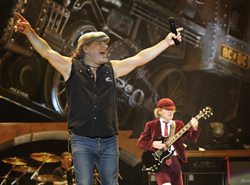
The next rack over is the RF rack unit. He’s using the new Shure LT wireless receivers and transmitters, the new Shure combiners that go from 400 to 900. “Ear-wise, I’m using Sennheiser G2 with an EK 300 belt packs and I’m using a Clair Brothers antenna combiner, And a four banger for my money shot through a Sennheiser vehicle antenna. I’m using a Sennheiser combiner and get the backline guys off another Sennheiser vehicle.”
Wailing across the stage was a pack of wedges. “The singers and the drummer have to have ears and also wedges. The in-ears are the new Ultimate Ears UE-11s. Down here in monitor world I’m using for cueing Sensaphonics Pro Phonic 2X’s in my ears.”
He added, “I do have the new 3-D and they are bad-ass but I don’t really need it in this environment just because it’s so loud coming off the stage. Brian and Phil are on UE-11’s because we felt we needed a product that would get over the 118 dB off the stage. I am monitoring their ears as well as the wedges with a Sensaphonics Promax.”
Jason Vrobel (AC/DC Crew Chief) has a list of credits on his resume that would make most 30-year vets stand up in awe. Kiss The Eagles, Eminem, U2, Alan Jackson, Paul McCartney, Green Day and Jackson Browne to just get started. He spent 1993 to 1997 in the navy as an Operations Specialist before going to school at Full Sail in Orlando.
A little while later he found himself on a Greyhound bus from Pittsburg to Dallas to interview with Leon Hopkins of Showco. Hopkins is still his boss. His work ethics as crew chief are hard pressed to surpass. He first worked with Mike Adams on the Kiss Farewell Tour and was John Roden’s monitor technician 2002-2004 Paul McCartney’s Back in the World Tour.
Dave Dixon (System Tech) is from the northwest of England. After working for a long time as a FOH engineer, Dixon decided to “have a go at system tech’ing. It was a conscious decision to go out and start working on systems. Unfortunately it sort of stuck!” he says with a chuckle. Dixon is a vet of The Stones, AC/DC and many others since he stared mixing in 1980.
“On the last tour the X-Array sounded great. So why change it? We could have used a line array I’m sure but a small looking PA the band wouldn’t have. They have a big sound, both visually and from an audio standpoint. The X-Array is a good-looking PA and it doesn’t take a lot of sight lines out. It’s a great system to tech.”
When I sat down with Kenny Check for our last interview of the day, it was just before showtime. I was in his comfort zone in the underworld of the AC/DC stage. This is where Check lives for the duration of the tour when he’s not mixing monitors for the support act The Answer. He’s tech’ing for Mike Adams, and is a vet of many AC/DC tours as well as the Stones, George Benson and many others. I opened up with a question about John Roden. He was visibly shaken on this subject – not what I intended to do minutes before the bell.
“Wow, the difficulty and the seriousness of the subject are incredible. Never have I before and perhaps again worked with someone that drives such a balance of the art and the technical. John drove me everyday, (but never asked) me to be the best, not only in audio, but in life. Truly one of my finest honors and privileges. After our touring together, I much more enjoyed the friendship with conversation of family and life. I miss John Roden everyday!”
Then Check had a show to do, and I had a system performance to experience.
The X-Array is amazing, with the tweaking that Witz and Clair have done serving as yet another testament to this industry’s technology forward leaps. All night, the PA sounded as good as any line array. It’s a fast machine, they keep the motors clean and as a result, AC/DC is now one of the best sounding shows that I’ve ever seen.
